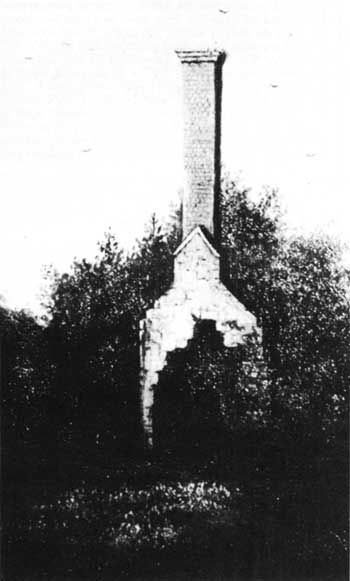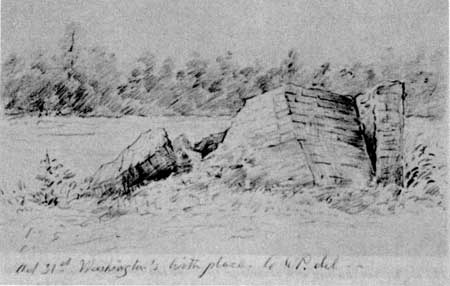|
GEORGE WASHINGTON BIRTHPLACE National Monument |
 |
A Century of Neglect
After the disastrous fire at Wakefield, 36 years passed before the birth site was marked. Finally, in 1815, George Washington Parke Custis (a grandson of Martha Washington and a ward of George Washington) visited Popes Creek and, in an imposing ceremony, marked what he considered to be the spot. Custis, in a letter to the editor of the Alexandria Gazette, described his visit in the following language:
In June, 1815, I sailed on my vessel, the "Lady of the Lake", a fine topsail schooner of ninety tons, accompanied by two gentlemen, Messrs. Lewis and Grimes, bound to Popes Creek in the County of Westmoreland, carrying with us a slab of freestone, having the following inscription:
"Here
The 11th of February, 1732, (Old Style)
George Washington
Was Born."We anchored some distance from the land, and taking to our boats, we soon reached the mouth of Pope's or Bridge's Creek, and proceeding upwards we fell in with McKenzie Beverly, Esq., and several gentlemen composing a fishing party, and also with the overseer of the property that formed the object of our visit. We were kindly received by these individuals, and escorted to the spot, where a few scattered bricks alone marked the birthplace of the chief.
Desirous of making the ceremonial of depositing the stone as imposing as circumstances would permit, we enveloped it in the "star spangled banner" of our country, and it was borne to its resting place in the arms of the descendants of four revolutionary patriots and soldiers.
We gathered together the bricks of an ancient chimney that once formed the hearth around which Washington in his infancy had played, and constructed a rude kind of pedestal, on which we reverently placed the FIRST STONE commending it to the respect and protection of the American people in general, and the citizens of Westmoreland County in particular.
Bidding adieu to those who had received us so kindly, we reembarked, and hoisted our colors, and being provided with a piece of cannon and suitable ammunition, we fired a salute, awakening the echoes that had slept for ages around the hallowed spot.
Custis' visit to Washington's birthplace is important for two reasons. First, the freestone slab which he placed at the birthsite was one of the earliest monuments erected in the United States as a memorial to George Washington. Secondly, Custis describes the site as it appeared in 1815 as a "spot where a few scattered bricks alone marked the birth place of the chief."

The old kitchen chimney at Wakefield in 1872, the
last surviving structure. It fell the next year.
From a painting
made by Sarah Pierrpont Barnard in 1872.
In 1832, the 100th anniversary of Washington's birth, the Alexandria Gazette noted how the nation had forgotten the ancient Popes Creek farm: "It is surprising that it [Wakefield] should be so little known and visited. Not one in a thousand of the passengers in Steamboats had any knowledge that this 'solum natale,' of him whom the whole world honors, is remote but a mile over the waters surface; and hid from his view only by a fringe of wild shrubbery. Will not Wakefield like Mt. Vernon, in after time, be the resort of Patriotic Pilgrims?"
In the July 1833 issue of The North American Magazine an unknown contributor gives a bit of important information about the birth home: "The old house of his [Washington's] birth has long since mouldered. The cellar over which it stood, now mostly filled up, is about fifty feet in length from east to west, having what seems to be a wine vault in the corner. An orchard of apple trees of modern growth interspersed with other fruit trees, surrounds the old cellar; westerly of which are scattered some apple trees of a very ancient growth, with fruit of a delicious flavour. These trees are monuments of olden times; contemporaries probably with the childhood of the Great Statesman."
As the years passed during the 19th century, others who visited Washington's birthplace commented on the neglected condition of the site. James K. Paulding of New York, a friend of Washington Irving and author of A Life of Washington, described Wakefield in 1835 as a place where "A few scanty relics alone remain to mark the spot . . . A clump of old decayed fig trees, probably coeval with the mansion, yet exists; a number of vines, and shrubs, and flowers still reproduce themselves every year as if to mark the spot."
In 1851 the Richmond Whig and Public Advertiser observed: "The birthplace of George Washington is . . . marked only by an old brick chimney, a mammoth fig tree, and a freestone slab . . . The slab is broken in two . . . The neglected condition of the spot bears shame against his country for neglecting to lift up a monument there, to his memory."
Five years later, in 1856, Bishop William Meade visited Wakefield and found Custis' freestone slab broken into fragments. The Bishop wrote: "I recently paid a visit to the old family seat of the Washingtons . . . The brick chimney is all that remains of the Washington mansion . . . except the broken bricks which are scattered about over the spot where it was built. The grandson of Mrs. General Washington, Mr. Custis, of Arlington, some years since placed a slab with a brief inscription on the spot, but it is now in fragments." The same year Bishop Meade visited Wakefield, Lewis W. Washington offered to the State of Virginia "sixty feet square of ground on which the house stood in which General Washington was born" together with the family burying ground, provided "that the State shall cause the premises to be permanently enclosed by an iron fence, based on a stone foundation, and shall mark the same by suitable, and modest, though substantial tablets, to commemorate for the rising generation these notable spots."

Ruins of the old kitchen chimney at
Wakefield.
From a sketch made by Charles C. Perkins in
1879.
Gov. Henry A. Wise was greatly interested in the offer, and visited Westmoreland County on April 27, 1858, for the purpose of inspecting the birthplace site and the Washington family burying ground. As a result of his visit and consequent recommendations, the Commonwealth of Virginia accepted the donation and appropriated $5,000 to carry out the wishes of Lewis W. Washington. Before the protective steps could be carried out, however, the drumbeats of war were echoing across the land, and only the ancient fig trees and wild shrubbery continued to mark the venerable spot.
Five years after the Civil War, a visitor to Wakefield observed that the freestone slab which George Washington Parke Custis had placed over the presumed birthsite with such loving care had disappeared. It had remained there only about 55 years before falling a victim to the vandalism of that time.
Some time in 1873 the old kitchen chimney, which had withstood the ravages of the elements for a century and a half, finally collapsed and fell to the ground. It had stood above ground longer than any other part of Augustine Washington's plantation buildings which he had built in the 1720's on Popes Creek.

|
|
Last Modified: Mon, Jan 20 2003 10:00:00 pm PDT |


